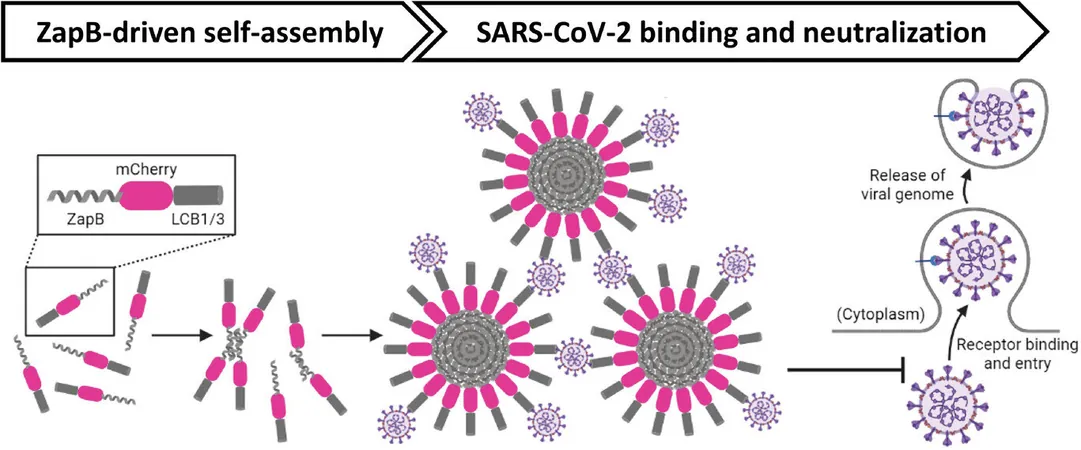
Revolutionary Nanoparticles Could Transform SARS-CoV-2 Neutralization and Virus Detection!
2024-11-06
Author: Daniel
Revolutionary Nanoparticles Could Transform SARS-CoV-2 Neutralization and Virus Detection!
In a groundbreaking study, researchers at the Institute for Biotechnology and Biomedicine of the Universitat Autònoma de Barcelona (IBB-UAB) have unveiled a new class of nanoparticles capable of effectively trapping and neutralizing significant amounts of SARS-CoV-2, the virus responsible for COVID-19. These novel nanoparticles operate efficiently, both in liquid solutions and directly on surfaces, opening up a realm of applications in public health and safety.
Innovative Design and Mechanism
The innovative nanoparticles, designated as LCB1-NPs and LCB3-NPs, are engineered from a fusion of specific proteins—leveraging the self-assembly properties of the ZapB protein. This strategic design enables these nanoparticles to enhance their antiviral properties and significantly increase their interaction with viral particles.
Revolutionizing Antiviral Materials
The researchers have highlighted the potential for these nanoparticles to revolutionize the production of antiviral materials. Imagine using them not only to create highly effective wastewater and air filtration systems but also to develop new tests for the early detection of COVID-19. In fact, there’s a tantalizing possibility that these particles can be reprogrammed to target various other pathogens, broadening their applicability beyond SARS-CoV-2.
Enhanced Binding Capability
Marc Fornt, a lead researcher in the study, explained, "Our nanoparticles can simultaneously bind to multiple virus particles, vastly improving their efficacy compared to existing materials that may only target one viral particle at a time." With this enhanced binding capability, the nanoparticles promise a new level of effectiveness in both therapeutic and preventative measures against COVID-19.
Fluorescence for Improved Tracking
Additionally, the nanoparticles display red fluorescence, which significantly simplifies the tracking and localization process during experimentation and application. Researchers successfully conducted tests that demonstrated these nanoparticles' capacity to capture and neutralize large viral quantities, paving the way for innovative virus filters that could mitigate viral spread, particularly in areas like hospitals.
Potential Applications in Public Health
Among their vast potential applications, the nanoparticles could provide solutions for filtering wastewater from COVID-19 patients, ensuring these harmful particles do not enter water systems. Furthermore, in hospital settings, they could enhance air quality, acting as a barrier against airborne transmission.
Ultra-Sensitive Detection Tests
The implications don’t stop there. The potential for ultra-sensitive early detection tests to diagnose COVID-19 could leverage these nanoparticles, allowing for accurate diagnoses even when viral loads are minimal, thus enabling prompt treatment and containment.
Industrial Appeal
Salvador Ventura, the study’s coordinator, pointed out the industrial appeal of the nanoparticles: “Their simplicity, rapid production speed, and cost-effectiveness make these nanoparticles an attractive option for widespread manufacturing of antiviral materials.”
Modular Approach to Nanoparticle Generation
What’s particularly striking about this research is the modular approach used in generating these nanoparticles. This means that the proteins responsible for recognizing and neutralizing SARS-CoV-2 can be substituted with others that target different pathogens, showcasing a remarkable versatility that could be vital in the ongoing fight against various infectious diseases.
Conclusion
As the world faces the ongoing challenges posed by COVID-19 and other possible pandemics, this breakthrough in nanotechnology may just hold the key to more resilient healthcare strategies in the near future. Keep an eye on these revolutionary nanoparticles—they might change the way we approach viral neutralization!




 Brasil (PT)
Brasil (PT)
 Canada (EN)
Canada (EN)
 Chile (ES)
Chile (ES)
 Česko (CS)
Česko (CS)
 대한민국 (KO)
대한민국 (KO)
 España (ES)
España (ES)
 France (FR)
France (FR)
 Hong Kong (EN)
Hong Kong (EN)
 Italia (IT)
Italia (IT)
 日本 (JA)
日本 (JA)
 Magyarország (HU)
Magyarország (HU)
 Norge (NO)
Norge (NO)
 Polska (PL)
Polska (PL)
 Schweiz (DE)
Schweiz (DE)
 Singapore (EN)
Singapore (EN)
 Sverige (SV)
Sverige (SV)
 Suomi (FI)
Suomi (FI)
 Türkiye (TR)
Türkiye (TR)
 الإمارات العربية المتحدة (AR)
الإمارات العربية المتحدة (AR)